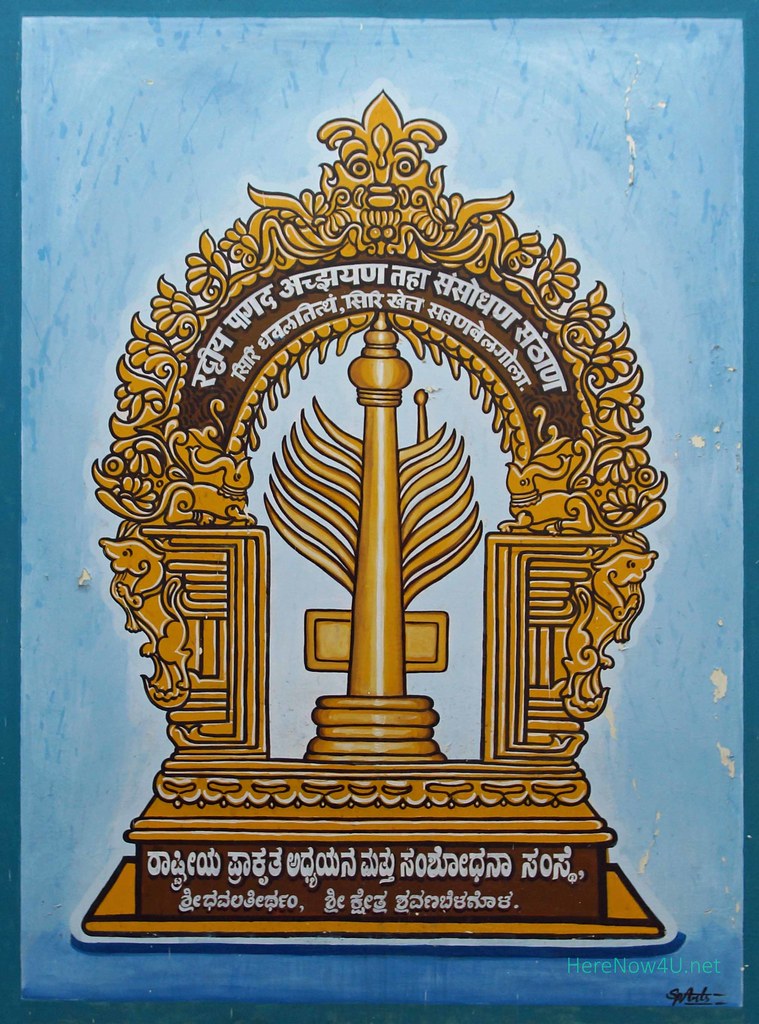
National Institute of Prakrit Studies and Research
National Institute of Prakrit Studies and Research [NIPSAR]
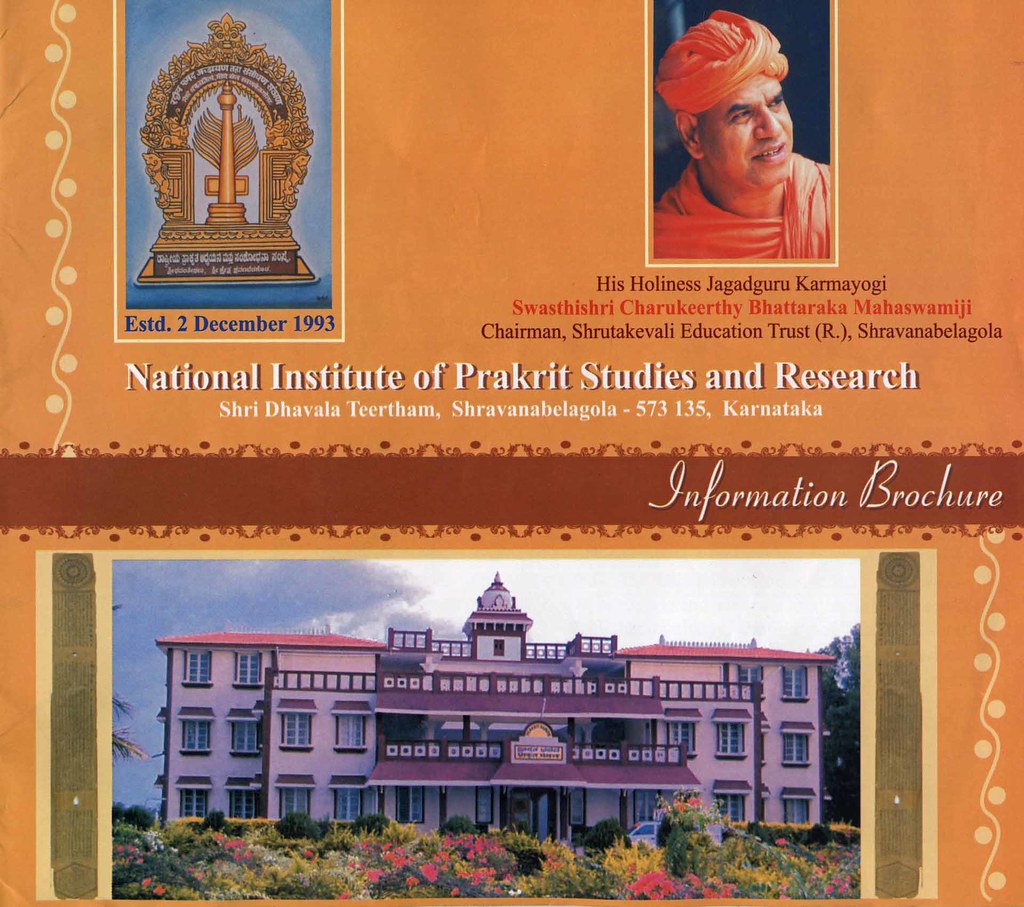
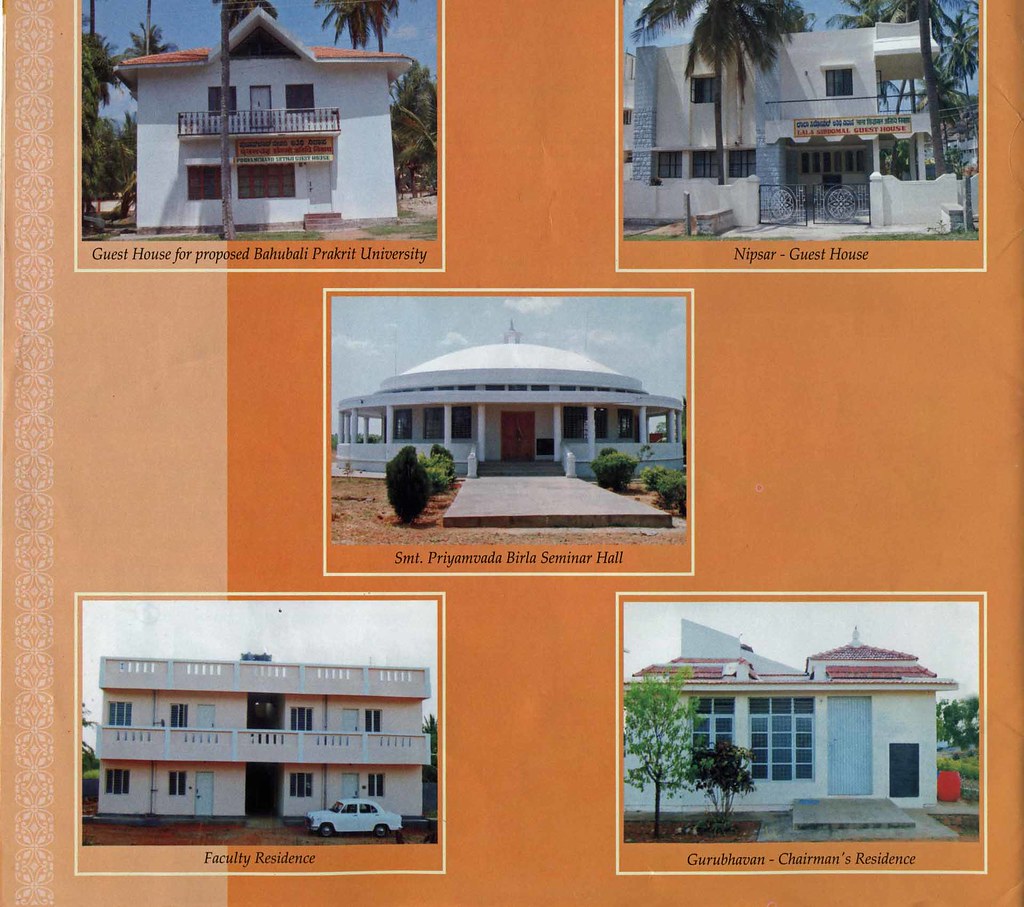
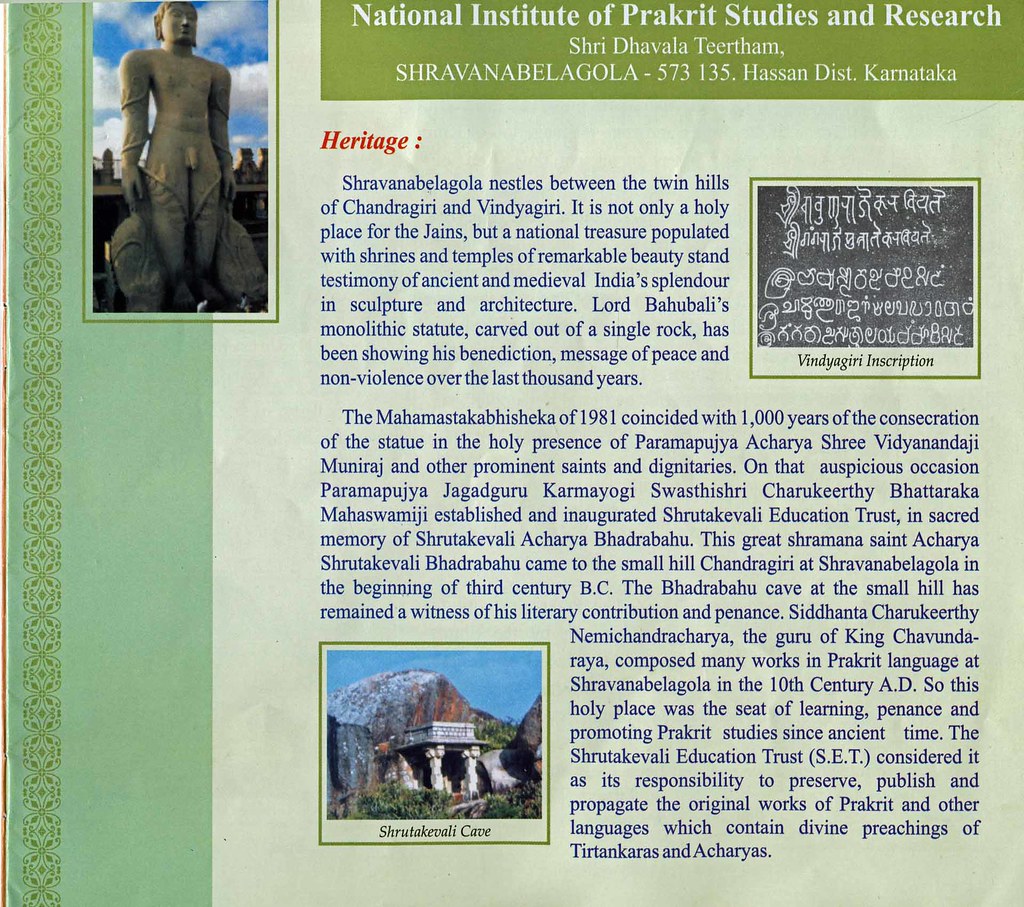
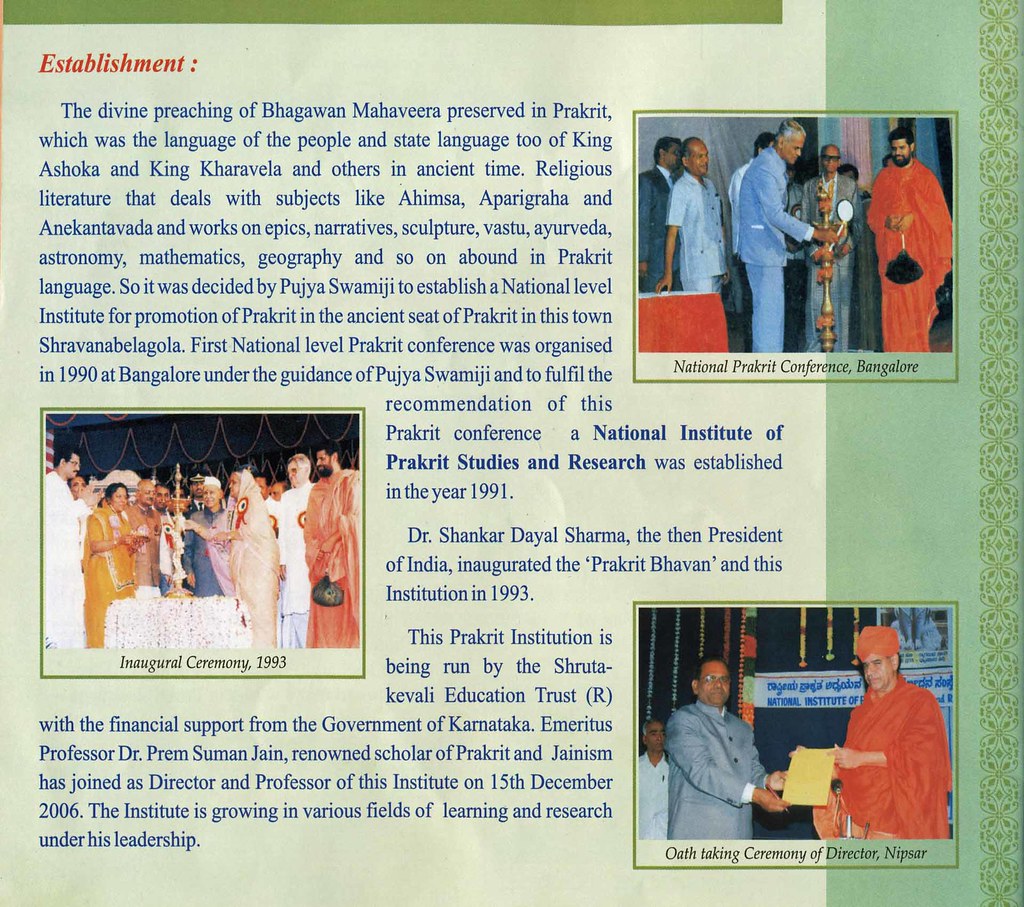


Further Expansion:
The Prakrit Bhavan campus is being expanded in its land of over 25 acres to facilitate effective learning and research. The Institute has planned construction of a) Administrative Block b) Faculty and class room block c) Library Building d) Manuscript Museum Building with project/editing and trans-lation wing e) Publication division f) Guest House and Staff Quarters g) Ayurvedic Therapy and Yoga Centre etc., These buildings are expected to come up within a year with the modem equipment.
The Original Shauraseni Prakrit Text Series:
The research work carried out at this institute focuses on oriental learning particularly in Prakrit, Apabhramsa, Kannada, Hindi and various aspects of Jainology under the able guidance of Pujya Swamiji, the Chairman of the Institute. The critical editions of all the Shauraseni Siddhanta Prakrit Texts are being prepared and some of them have been published under the editorship of eminent scholar Prof. Bhagachandra Jain Bhaskar, a recipient of Presidents award in Pali-Prakrit, and Joint Director of the Institute. (A) Kashayapahuda of Gunadharacharya and (B) Kundakunda Granthavali have been published in original Prakrit text series. The others are under process. All Shauraseni Prakrit Siddhanta Texts are being edited and published in the same size for the first time by this Institute.
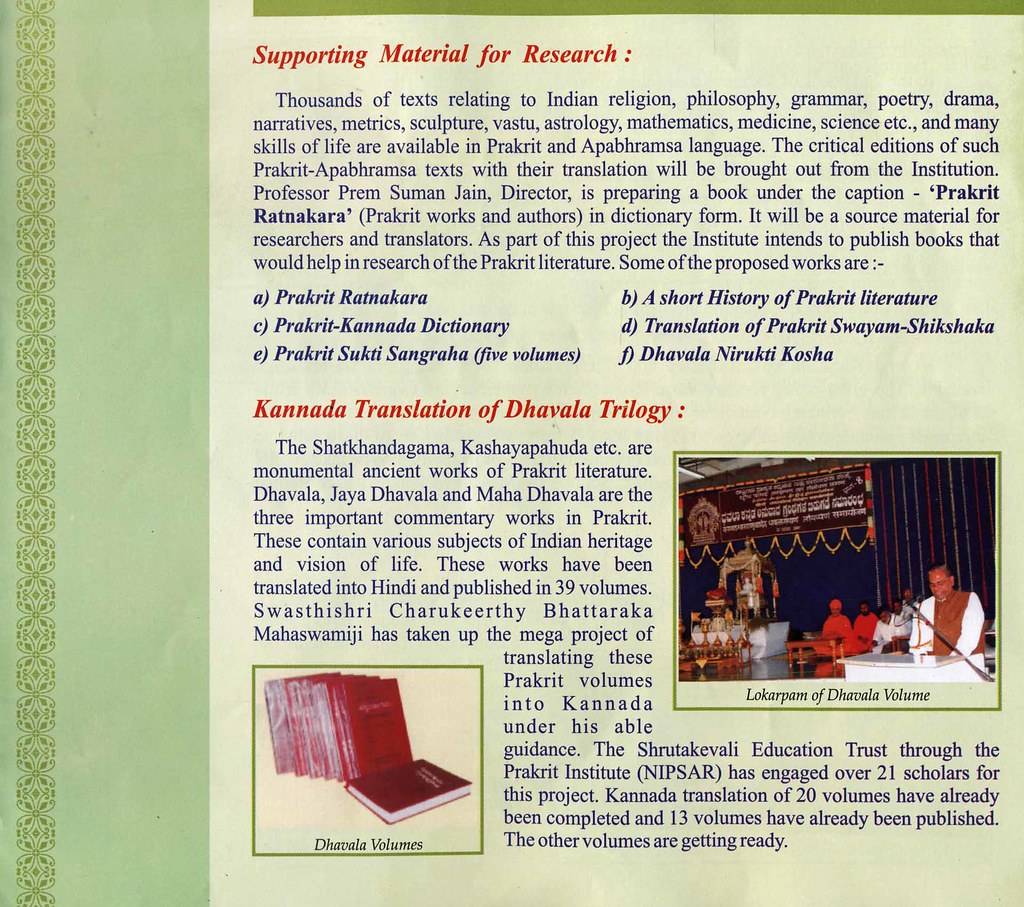
Supporting Material for Research:
Thousands of texts relating to Indian religion, philosophy, grammar, poetry, drama, narratives, metrics, sculpture, vastu, astrology, mathematics, medicine, science etc., and many skills of life are available in Prakrit and Apabhramsa language. The critical editions of such Prakrit-Apabhramsa texts with their translation will be brought out from the Institution. Professor Prem Suman Jain, Director, is preparing a book under the caption - 'Prakrit Ratnakara' (Prakrit works and authors) in dictionary form. It will be a source material for researchers and translators. As part of this project the Institute intends to publish books that would help in research of the Prakrit literature. Some of the proposed works are:
a) Prakrit Ratnakara
b) A short History of Prakrit literature
c) Prakrit-Kannada Dictionary
d) Translation of Prakrit Swayam-Shikshaka
e) Prakrit Sukti Sangraha (five volumes)
f) Dhavala Nirukti Kosha
Kannada Translation of Dhavala Trilogy:
The Shatkhandagama, Kashayapahuda etc. are monumental ancient works of Prakrit literature. Dhavala, Jaya Dhavala and Maha Dhavala are the three important commentary works in Prakrit. These contain various subjects of Indian heritage and vision of life. These works have been translated into Hindi and published in 39 volumes. Swasthishri Charukeerthy Bhattaraka Mahaswamiji has taken up the mega project of translating these Prakrit volumes into Kannada under his able guidance. The Shrutakevali Education Trust through the Prakrit Institute (NIPSAR) has engaged over 21 scholars for this project. Kannada translation of 20 volumes have already been completed and 13 volumes have already been published. The other volumes are getting ready.

Kannada Translation of Dhavaletara Prakrit Texts:
In the 2nd phase of Kannada translation project, a few Kannada scholars are engaged in translating the other Dhavaletara Prakrit texts in to Kannada under the editorship and convenership of Dr. M.A. Jayachandra. The Maranakandika text has been published with Kannada translation by the Institute. The other texts are getting ready. Scholars in Karnataka engaged in comparative studies will be immensely benefited by these publications. The faculty of Institute and Trustees of S.E.T. hope to re-establish the link between Prakrit and Kannada that was lost owing to various reasons.
Kannada Commentaries and Interpretations of Prakrit Texts:
Several Kannada commentaries and interpretations of ancient Prakrit texts are available. The great writer Keshavavarni has written commentary on Gommatasara while Mallishena has written commentary on Samayasara. Some unknown poets have also composed valuable commentaries on Prakrit texts. Editing and publishing of these valuable commentaries will be beneficial in the field of Indology. This project will also be taken up by the Institute in due course. Renowned Kannada Scholar Dr. M.A. Jayachandra has consented to be the Chief Editor this project.
Extension and Teaching and Research Programme:
Under the extension activities one branch of this Institute has been set up at Bijapur. Pt. Shri Ratanchand Neminath Koti, Dy. Director, is looking after this branch. There is an Examination Department in the NIPSAR. This Department is running Diploma and Certificate correspondence courses in Prakrit literature through Kannada medium to the students of Karnataka. There are over 100 students pursuing the certificate course and 90 students pursuing Diploma course. The qualified staff of the Institute have prepared the lessons according to the syllabus and teaches to the students in contact class under the able guidance of Prof. Jeevandhar Kumar Hotapeti, H.O.D of Prakrit Teaching Department and examination. The staff of the Institute and faculty
members of the Dept. of Jainology and Prakrit, University of Mysore are also helping in teaching work. The Annual Convocations are being held for these students under the Chairmanship of Pujya Swamiji.Prakrit Balabodha and Payiya Pavesia Prakrit text books written by Prof. P.S. Jain have been published in Kannada for the beginners of Prakrit learning. Other books on Prakrit teaching are under preparation. The academic staff of the Institute are engaged in teaching/editing texts and research work also. Our research scholars - Dr. Siddharth, Dr. Dinesh, Dr. Swayamprabha P. Patil and Dr. Veena Patil of the Institute have been awarded Ph.D. degree in Jainology and Prakrit by the University of Mysore under the guidance of Dr. N. Suresh Kumar, former Director of the Institute. Two research fellows are now working for Ph.D. under the present Director.
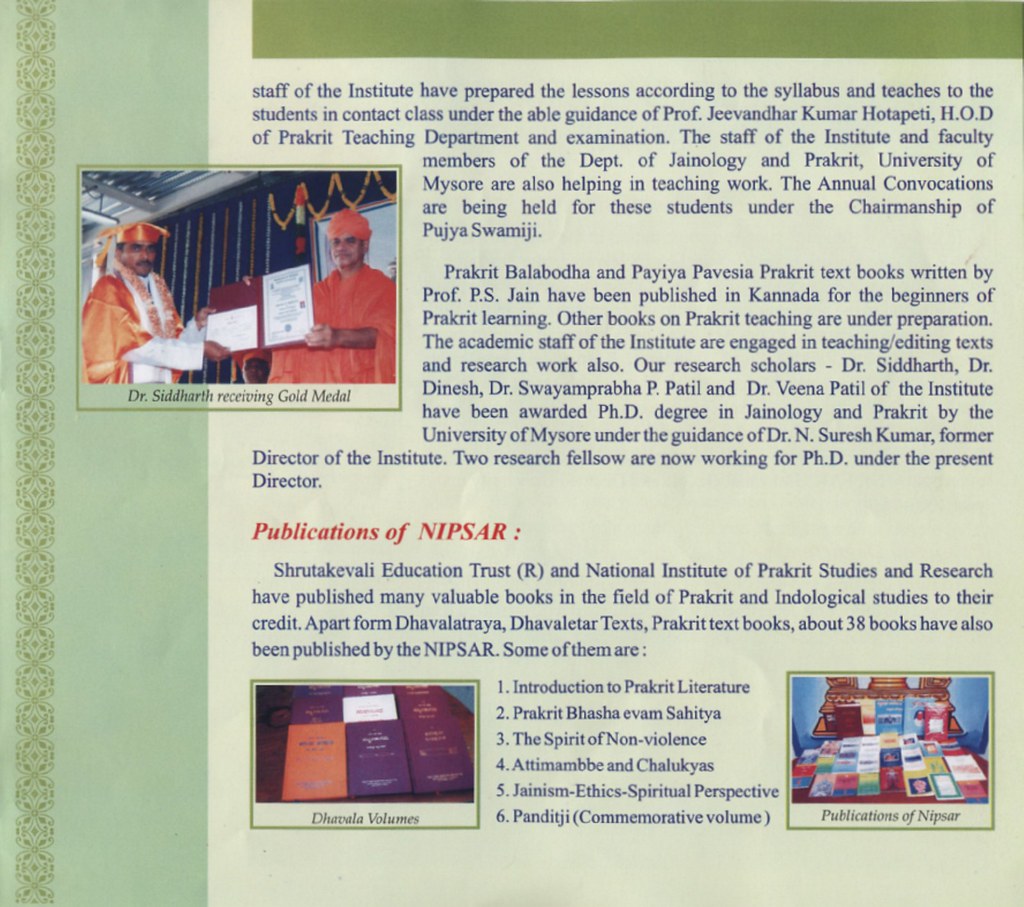
NIPSAR Information Brochure 09
Publications of NIPSAR:
Shrutakevali Education Trust (R) and National Institute of Prakrit Studies and Research have published many valuable books in the field of Prakrit and Indological studies to their credit. Apart form Dhavalatraya, Dhavaletar Texts, Prakrit text books, about 3 8 books have also been published by the NIPSAR. Some of them are:
1. Introduction to Prakrit Literature
2. Prakrit Bhasha evam Sahitya
3. The Spirit of Non-violence
4. Attimambbe and Chalukyas
5. Jainism-Ethics-Spiritual Perspective
6. Panditji (Commemorative volume)The Institute has decided to bring out a Journal of the Institute namely 'Payiyatitha' in English, Kannada and Hindi languages and a newsletter in the month of Dcember 2007 under the general editorship of the Director of NIPSAR and Managing Editor Shri Jalathkumar Punajagauda.
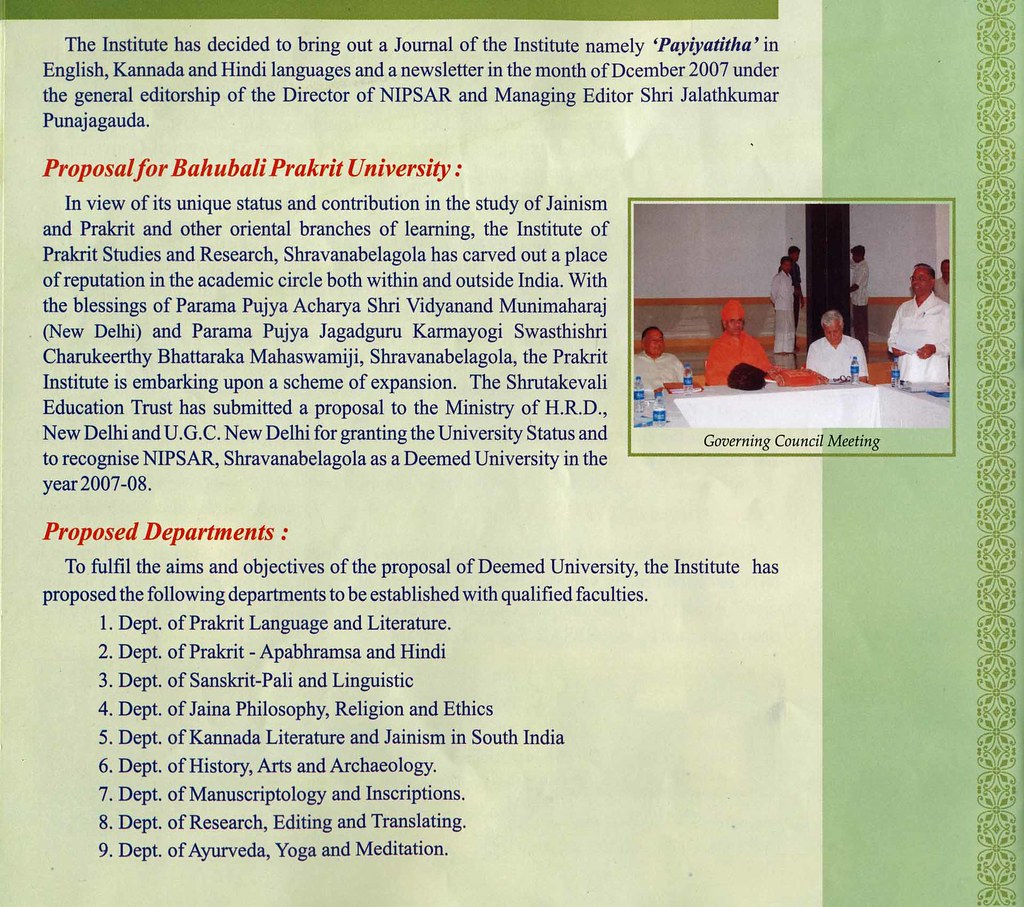
Proposal for Bahubali Prakrit University:
In view of its unique status and contribution in the study of Jainism and Prakrit and other oriental branches of learning, the Institute of Prakrit Studies and Research, Shravanabelagola has carved out a place of reputation in the academic circle both within and outside India. With the blessings of Parama Pujya Acharya Shri Vidyanand Munimaharaj (New Delhi) and Parama Pujya Jagadguru Karmayogi Swasthishri Charukeerthy Bhattaraka Mahaswamiji, Shravanabelagola, the Prakrit Institute is embarking upon a scheme of expansion. The Shrutakevali Education Trust has submitted a proposal to the Ministry of H.R.D., New Delhi and U.G.C. New Delhi for granting the University Status and to recognise NIPSAR, Shravanabelagola as a Deemed University in the year 2007-08.
Proposed Departments:
To fulfil the aims and objectives of the proposal of Deemed University, the Institute has proposed the following departments to be established with qualified faculties.
1. Dept. of Prakrit Language and Literature.
2. Dept. of Prakrit - Apabhramsa and Hindi
3. Dept. of Sanskrit-Pali and Linguistic
4. Dept. of Jaina Philosophy, Religion and Ethics
5. Dept. of Kannada Literature and Jainism in South India
6. Dept. of History, Arts and Archaeology.
7. Dept. of Manuscriptology and Inscriptions.
8. Dept. of Research, Editing and Translating.
9. Dept. of Ayurveda, Yoga and Meditation.
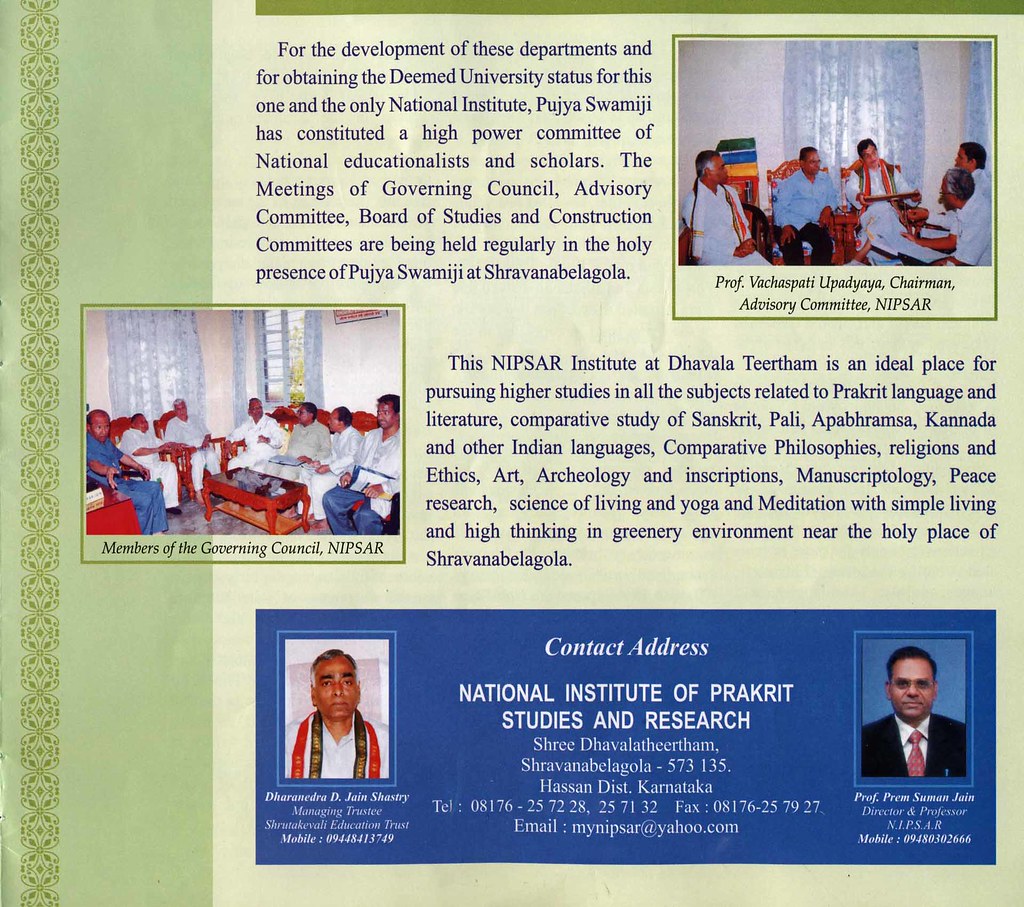
For the development of these departments and for obtaining the Deemed University status for this one and the only National Institute, Pujya Swamiji has constituted a high power committee of National educationalists and scholars. The Meetings of Governing Council, Advisory Committee, Board of Studies and Construction Committees are being held regularly in the holy presence of Pujya Swamiji at Shravanabelagola.
This NIPSAR Institute at Dhavala Teertham is an ideal place for pursuing higher studies in all the subjects related to Prakrit language and literature, comparative study of Sanskrit, Pali, Apabhramsa, Kannada and other Indian languages, Comparative Philosophies, religions and Ethics, Art, Archeology and inscriptions, Manuscriptology, Peace research, science of living and yoga and Meditation with simple living and high thinking in greenery environment near the holy place of Shravanabelagola.
Contact Address:
NATIONAL INSTITUTE OF PRAKRIT STUDIES AND RESEARCH
Shree Dhavalatheertham, Shravanabelagola - 573 135. Hassan Dist. Karnataka
Tel: 08176 - 25 72 28, 25 71 32 Fax: 08176-25 79 27
Email:Dharanedra D. Jain Shastry
Prof. Prem Suman Jain
Managing Trustee Shrutakevali Education Trust
Mobile; 09448413749
Director & Professor
N.I.P.S.A.R
Mobile: 09480302666
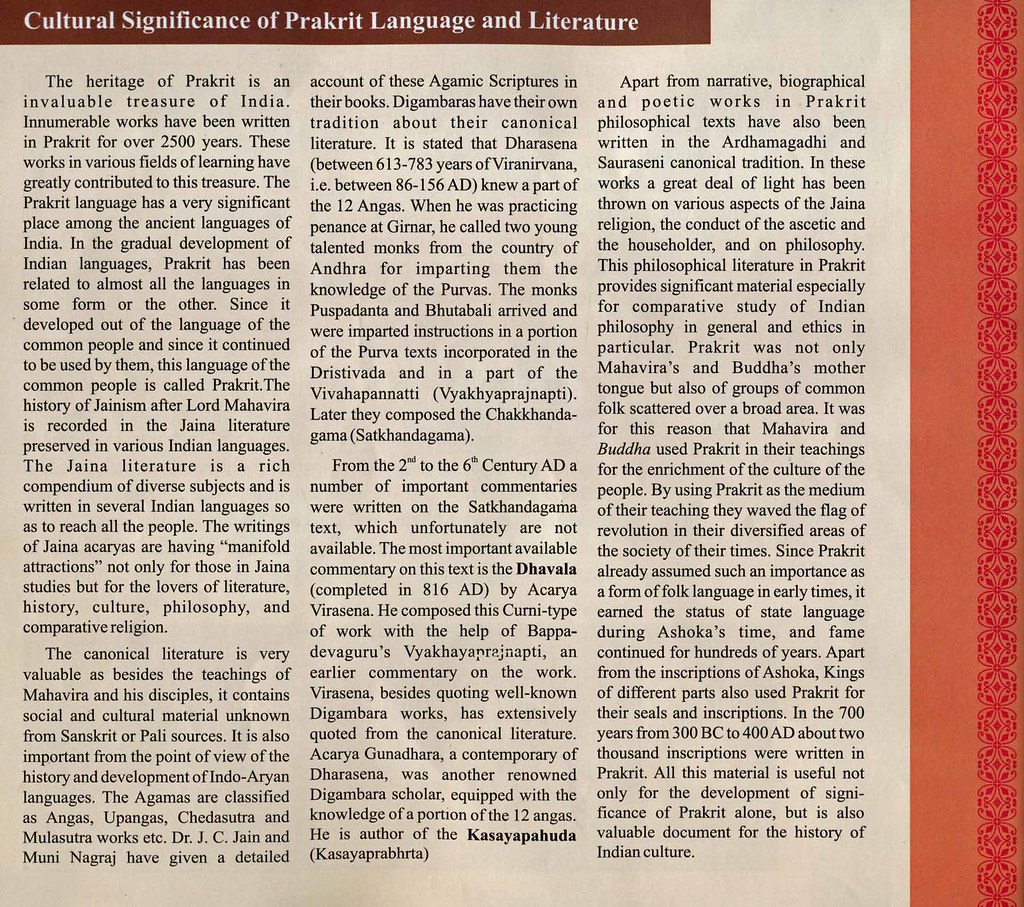
Cultural Significance of Prakrit Language & Literature
The heritage of Prakrit is an invaluable treasure of India. Innumerable works have been written in Prakrit for over 2500 years. These works in various fields of learning have greatly contributed to this treasure. The Prakrit language has a very significant place among the ancient languages of India. In the gradual development of Indian languages, Prakrit has been related to almost all the languages in some form or the other. Since it developed out of the language of the common people and since it continued to be used by them, this language of the common people is called Prakrit.The history of Jainism after Lord Mahavira is recorded in the Jaina literature preserved in various Indian languages. The Jaina literature is a rich compendium of diverse subjects and is written in several Indian languages so as to reach all the people. The writings of Jaina acaryas are having "manifold attractions" not only for those in Jaina studies but for the lovers of literature, history, culture, philosophy, and comparative religion.
The canonical literature is very valuable as besides the teachings of Mahavira and his disciples, it contains social and cultural material unknown from Sanskrit or Pali sources. It is also important from the point of view of the history and development of Indo-Aryan languages. The Agamas are classified as Angas, Upangas, Chedasutra and Mulasutra works etc. Dr. J. C. Jain and Muni Nagraj have given a detailed account of these Agamic Scriptures in their books. Digambaras have their own tradition about their canonical literature. It is stated that Dharasena (between 613-783 years of Viranirvana, i.e. between 86-156 AD) knew a part of the 12 Angas. When he was practicing penance at Girnar, he called two young talented monks from the country of Andhra for imparting them the knowledge of the Purvas. The monks Puspadanta and Bhutabali arrived and were imparted instructions in a portion of the Purva texts incorporated in the Dristivada and in a part of the Vivahapannatti (Vyakhyaprajnapti). Later they composed the Chakkhanda-gama (Satkhandagama).
From the 2nd to the 6th Century AD a number of important commentaries were written on the Satkhandagama text, which unfortunately are not available. The most important available commentary on this text is the Dhavala (completed in 816 AD) by Acarya Virasena. He composed this Curni-type of work with the help of Bappa-devaguru's Vyakhayaprajnapti, an earlier commentary on the work. Virasena, besides quoting well-known Digambara works, has extensively quoted from the canonical literature. Acarya Gunadhara, a contemporary of Dharasena, was another renowned Digambara scholar, equipped with the knowledge of a portion of the 12 angas. He is author of the Kasayapahuda (Kasayaprabhrta)
Apart from narrative, biographical and poetic works in Prakrit philosophical texts have also been written in the Ardhamagadhi and Sauraseni canonical tradition. In these works a great deal of light has been thrown on various aspects of the Jaina religion, the conduct of the ascetic and the householder, and on philosophy. This philosophical literature in Prakrit provides significant material especially for comparative study of Indian philosophy in general and ethics in particular. Prakrit was not only Mahavira's and Buddha's mother tongue but also of groups of common folk scattered over a broad area. It was for this reason that Mahavira and Buddha used Prakrit in their teachings for the enrichment of the culture of the people. By using Prakrit as the medium of their teaching they waved the flag of revolution in their diversified areas of the society of their times. Since Prakrit already assumed such an importance as a form of folk language in early times, it earned the status of state language during Ashoka's time, and fame continued for hundreds of years. Apart from the inscriptions of Ashoka, Kings of different parts also used Prakrit for their seals and inscriptions. In the 700 years from 300 BC to 400 AD about two thousand inscriptions were written in Prakrit. All this material is useful not only for the development of significance of Prakrit alone, but is also valuable document for the history of Indian culture.

Prakrit developed very gradually. By the first centuries of the Christian era Prakrit began to be respected from the cottages of the villages to the assemblies of courts, so much so that it was adopted as a powerful medium of communication in the society. By compiling the gathas of various Prakrit poets in his Gathasaptsati, the great poet Hala made Prakrit a language which can be used not only to depict village life but also for aesthetics. Kalidasa and other distinguished poets gave a prominent place to the role of Prakrit speakers in their dramas because of the attraction of the common people towards the Prakrit language. The poetic beauty and sweetness of the language is inherent in all the works written in Prakrit, such as the Agama texts, the commentarial literature, the narratives and the biographies. In these works Prakrit has maintained a continuity of these qualities throughout its life of 2300 years. In their writings Indian literary critics have also preserved hundreds of Prakrit verses in the form of quotations, because of their simplicity and sweetness. In this way Prakrit has always enlivened the views of the country, of ethics and of the literary world. And, thus, Prakrit has been the vehicle for Indian culture.
Jaina Works on Scientific subjects:
Jaina literature not only satisfies the interests of the common man, but also his desire for knowledge. Apart from Prakrit works on poetry, narratives, the Jaina canon and philosophy, there are innumerable secular writings in Prakrit and other languages on Grammar, Metre, lexicography, mathematics, astrology and music, and other subjects as well. This kind of literature contains various new insights with regard to the knowledge and wisdom of Indian literature. The Suriyapannatti, the fifth text of Upanga Agama, deals with astromony and the Candapannatti, the seventh text of Upanga Agama, describes astrology of Indian tradition. Vivahapadala is another Prakrit work which deals with wedding astrology. The Tiloyapannatti, Gommatasara and other many Prakrit texts are considered essential for the history of Indian mathematics. The Paiyalacchinamamala is representive work of lexicography. The Angavijja Prakrit work is famous for secular sciences and other subjects. Further more, the significance of Prakrit poetry is evident by the fact that all the Acaryas who are famous as literary critics in India have given examples from Prakrit gathas in their works in order to illustrate their definitions of poetry. The PrakriPaingalam and Alamkaradappana are closely related with Indian poetics. Not only this, secular view of life in ancient India is depicted in Prakrit literature, which is of great value to the social and cultural history of India.
Importance of Jaina Granth Bhandars:
Grantha Bhandars are the ealier literary institutions of the country. The Grantha Bhandars were the literary centres in true sense. They provided help to the scholars and reading public in enhancing their knowledge. But their importance lies not only in this but also in the fact that they saved the treasure of knowledge from destruction. In this respect, the contribution of Jainas is really great. Even today the earliest and authentic manuscripts of several works written by scholars other than the Jainas are preserved only in these bhandars. The Grantha Bhandars are very important from the historical point of view. There are several works exclusively on the subject of History. Besides, we find that the authors and copyists of the manuscripts give some description of the rulers, cities or towns where they wrote or copied and the patrons who encouraged learning. Such colophons called prasastis, are written generally either at the end or in the beginning of the works. On the basis of these, the time of many rulers can be determined and history of old cities and towns can be prepared. As manuscripts dated from 10th centruy onwards are available, so a history of past one thousand year can be reconstructed also on the basis of the material found in the Jaina Grantha Bhandars. The Grantha Bhandars are not only the treasure houses for the books written by the Jaina writers but they are also the good centres for the manuscripts written by the scholars other than Jaina. The Sadhus and also the house-holders made no difference while collecting the manuscripts for these Bhandars and they collected them giving the same importance to the manuscripts are also such, which are available in these Jaina Bhandars alone.
Prof. Prem Suman Jain
Director - NIPSAR

Patron and Chairman | : | H.H. Jagadguru Karmayogi Swasthishree Charukeerthy Bhattaraka Swamyji |
Governing Council Chairman | : | Dr. T. C. Kothari, New Delhi |
Advisory Committee Chairman | : | Prof. Vachaspati Upadhyay, New Delhi |
Board of Studies Chairman | : | Prof. Raja Ram Jain, Noida |
Director & Professor | : | Prof. Prem Suman Jain |
Joint Director | : | Prof. B.C. Jain Bhaskar |
Dy. Director | : | Pt. Shri Ratan Chand N. Koti |
Convenor, Translation Project | : | Dr. M.A. Jayachandra |
Curator, Manuscripts Museum | : | Prof. B.S. Sannaiah |
Managing Trustee | : | Shri Dharanendra D. Jain Shastry |
Executive Officer | : | Shri Uday Raj |
Publication Officer | : | Shri S. Jithendra Kumar |
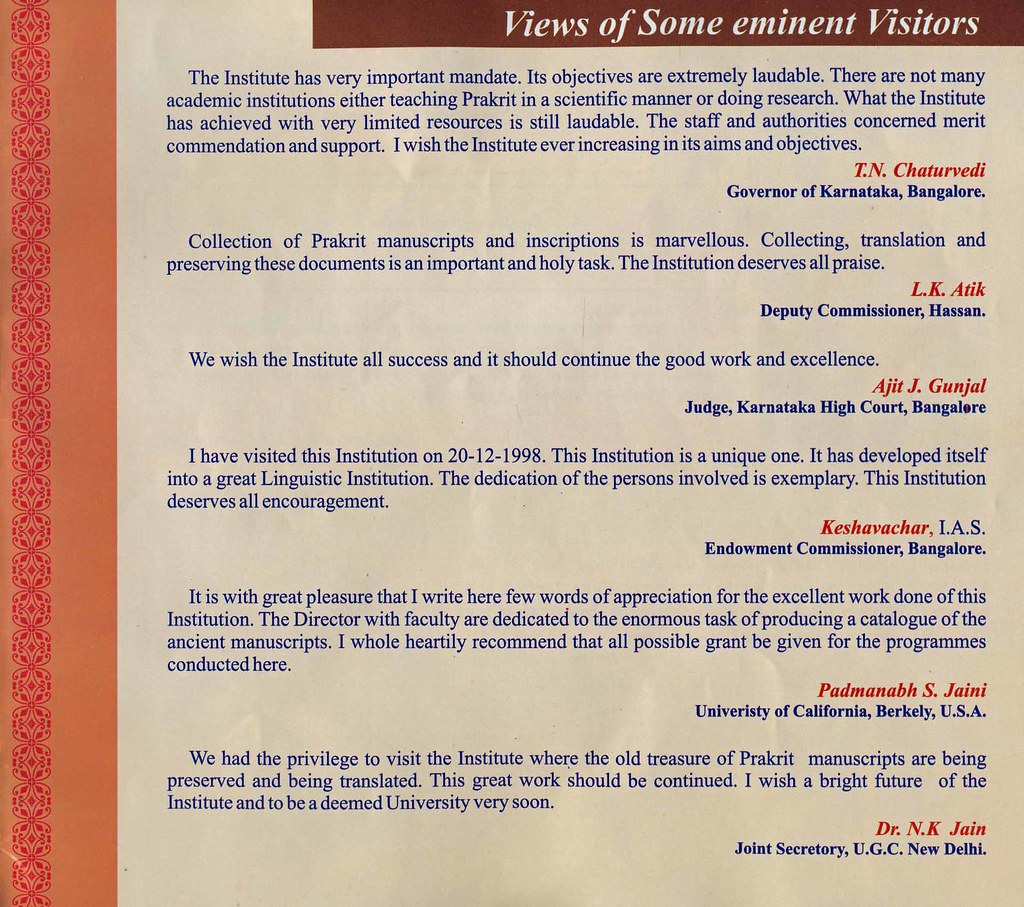
Views of Some Emonent Visitors:
The Institute has very important mandate. Its objectives are extremely laudable. There are not many academic institutions either teaching Prakrit in a scientific manner or doing research. What the Institute has achieved with very limited resources is still laudable. The staff and authorities concerned merit commendation and support. I wish the Institute ever increasing in its aims and objectives.
T.N. Chaturvedi
Governor of Karnataka, Bangalore
Collection of Prakrit manuscripts and inscriptions is marvellous. Collecting, translation and preserving these documents is an important and holy task. The Institution deserves all praise.
L.K. Atik
Deputy Commissioner, Hassan
We wish the Institute all success and it should continue the good work and excellence.
AjitJ. Gunjal
Judge, Karnataka High Court, Bangalore
I have visited this Institution on 20-12-1998. This Institution is a unique one. It has developed itself into a great Linguistic Institution. The dedication of the persons involved is exemplary. This Institution deserves all encouragement.
Keshavachar,
I.A.S. Endowment Commissioner, Bangalore
It is with great pleasure that I write here few words of appreciation for the excellent work done of this Institution. The Director with faculty are dedicated to the enormous task of producing a catalogue of the ancient manuscripts. I whole heartily recommend that all possible grant be given for the programmes conducted here.
Padmanabh S. Jaini
Univeristy of California, Berkely, U.S.A.
We had the privilege to visit the Institute where the old treasure of Prakrit manuscripts are being preserved and being translated. This great work should be continued. I wish a bright future of the Institute and to be a deemed University very soon.
Dr. N.K Jain
Joint Secretary, U.G.C. New Delhi.

Chairman: H.H. Jagadguru Karmayogi Swasthishri Charukeerthy Bhattaraka Swamiji
Managing Trustee: Shri Dharanendra D. Jain
Prakrit studies and research have been always important, but in present age these have an importance and relevance as never before. The most important human endeavour today is to strive towards an age of Science and Ahimsa. Man s very survival depends on it.
Dr. D.S. Kothari
Ex. Chancellor, J.N. U. New Delhi
Prakrit languages have played an important role in the history of Indian culture, but, to our regret, due attention has not yet been paid to them by Indologists. In Prakrit so many attractive literary works have been whitened.
Prof. Hajime Nakamura
Founder Director, The Eastern Institute, Inc.
Tokyo, Japan